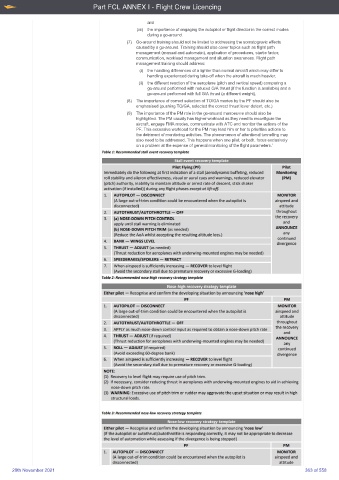Page 363 - UK Aircrew Regulations (Consolidated) 201121
P. 363
Part FCL ANNEX I - Flight Crew Licencing
and
(vii) the importance of engaging the autopilot or flight director in the correct modes
during a go-around.
(7) Go-around training should not be limited to addressing the somatogravic effects
caused by a go-around. Training should also cover topics such as flight path
management (manual and automatic), application of procedures, startle factor,
communication, workload management and situation awareness. Flight path
management training should address:
(i) the handling differences of a lighter than normal aircraft which may differ to
handling experienced during take-off when the aircraft is much heavier;
(ii) the different reaction of the aeroplane (pitch and vertical speed) comparing a
go-around performed with reduced G/A thrust (if the function is available) and a
go-around performed with full G/A thrust (a different weight).
(8) The importance of correct selection of TO/GA modes by the PF should also be
emphasised (pushing TO/GA, selected the correct thrust lever detent, etc.)
(9) The importance of the PM role in the go-around manoeuvre should also be
highlighted. The PM usually has higher workload as they need to reconfigure the
aircraft, engage FMA modes, communicate with ATC and monitor the actions of the
PF. This excessive workload for the PM may lead him or her to prioritise actions to
the detriment of monitoring activities. The phenomenon of attentional tunnelling may
also need to be addressed. This happens when one pilot, or both, focus exclusively
on a problem at the expense of general monitoring of the flight parameters.’
20th November 2021 363 of 558

